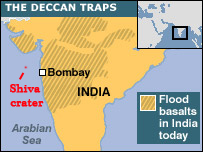In Search of Dinosaur Extinction Theories – The “Shiva” Crater
The controversial tear-drop shaped Shiva crater located off the western coast of India has divided opinions for decades. Whilst many people may be familiar with the extra-terrestrial impact theory that led to the end Cretaceous mass extinction event, most would argue that the Chicxulub crater located off the coast of the Yucatan peninsula (Mexico) is the most likely candidate for that “smoking gun” evidence to indicate that a large body from outer space crashed into the Earth.
Extinction Theories
Not so, according to Professor Sankar Chatterjee and his colleagues. Professor Chatterjee, a Horn Professor of Palaeontology and the Curator at the Museum of Texas Tech University, believes that an object from space perhaps a comet or an asteroid, some forty kilometres in diameter smashed into the Earth around sixty-six million years ago and this too contributed to the Cretaceous-Palaeogene extinction event.
The Shiva Crater
The Shiva crater is named after the Hindu god of destruction, transformation and renewal. It is estimated to be around six hundred kilometres in length and around four hundred kilometres across at its widest part. Professor Chatterjee has been awarded the prestigious “Fulbright-Nehru Academic and Professional Excellence Award”, which includes a grant which the Indian-American scholar intends to use to fund a visit to Western India next spring to continue his research on the crater.
The Fulbright Programme is an international educational exchange programme sponsored by the Government of the United States with the aim of increasing mutual understanding between the people of America and the rest of the world. Professor Chatterjee will join the Koyna Drilling Project and analyse rock cores drilled through the sea bed in a bid to establish the age of this geological phenomena and to learn more about its formation.
Professor Sankar Chatterjee (Texas Tech University)
Picture credit: Texas Tech University
Dinosaur Extinction
The crater was discovered when geophysical surveys of the Mumbai Offshore Basin revealed a huge, tear-drop shaped depression in the strata that forms the western continental shelf of India. The crater is buried under layers of rock which are between two kilometres and seven kilometres deep. Professor Chatterjee explains that the strange shape of the crater may have been caused by the shallow angle of trajectory or by subsequent rock falls or as a result of ancient volcanic activity – after throws of the immense volcanism that led to the formation of the extensive Deccan Traps. The area is believed to hold vast reserves of fossil fuels, both crude oil and natural gas.
For replicas and models of Late Cretaceous prehistoric animals: Wild Safari Prehistoric World Figures and Models.
It is hoped that this new research will confirm that this crater was caused by an extra-terrestrial impact, a theory challenged by a number of scientists and academics who contend that this feature does not represent an impact crater at all. The Shiva crater for example, is not recorded on the Earth Impact Database of the Planetary and Space Science Centre at the University of Brunswick (Canada).
The Site of the Shiva Crater in Relation to the Deccan Traps
Last year, Everything Dinosaur reported on some new research carried out by an international team of scientists that dated the Chicxlub crater to 66,038,000 years ago (plus or minus 11,000 years). This was the most accurate date proposed yet and places the impact event at around the time of the extinction event that wiped out the dinosaurs and about seventy percent of all terrestrial life.
To read more about this research: Most Accurate Date Yet Established for Chicxulub Impact Crater.
It has also been suggested that no, one single extraterrestrial impact event was the cause of the extinctions. Indeed, it has been suggested that the dinosaurs, pterosaurs and other groups that perished may have been subjected to more than one Earth/space collision. In addition, Everything Dinosaur reported last year on research that proposed a comet was the most likely culprit for the Yucatan peninsula impact.
To read this article: American Researchers Propose Comet Caused the Chicxulub Crater.








Leave A Comment